Explore Smart Glasses for the Visually Impaired and Their Benefits
Explore Smart Glasses for the Visually Impaired and Their Benefits
Blog Article
Discover Innovative Devices Created for the Visually Impaired
The advancement of ingenious devices for the visually damaged stands for a considerable development in availability and freedom. Technologies such as wise glasses with AI abilities and mobile applications made to offer auditory descriptions are improving daily experiences for individuals. In addition, wearable devices that employ haptic responses enhance ecological understanding, while modern Braille developments offer brand-new means to involve with message. As these tools remain to evolve, their influence on the lives of those with visual disabilities elevates vital inquiries about the future of inclusivity and autonomy in different facets of life. What exists ahead in this technical landscape?
Smart Glasses for Navigating

Smart glasses made for navigation are transforming the means visually impaired people connect with their environment. These sophisticated tools use a combination of cam innovation, expert system, and acoustic comments to provide real-time details regarding surroundings. By using challenge detection systems, wise glasses can inform customers to potential hazards, making it possible for much safer movement in both unfamiliar and familiar settings.
The integration of GPS modern technology further boosts navigation abilities, enabling individuals to obtain auditory directions as they relocate. This hands-free technique not just cultivates independence yet also empowers visually impaired people to browse urban landscapes with raised self-confidence. Furthermore, many clever glasses are outfitted with features that determine landmarks and road indications, giving contextual details that enhances the individual experience.
Furthermore, the advancement of these devices is constantly advancing, with firms working to boost the accuracy of object recognition and expand the series of navigational functions. As clever glasses become a lot more available and inexpensive, they hold the prospective to substantially transform day-to-day live for aesthetically damaged users. Eventually, these cutting-edge devices represent a crucial action towards inclusivity, offering enhanced wheelchair and a better sense of autonomy for people navigating the globe around them.
%20(1).webp)
Mobile Application for Daily Living
Exactly how can mobile applications boost the everyday lives of aesthetically impaired people? Mobile applications are transforming the means aesthetically damaged users navigate their atmospheres, manage everyday jobs, and access information. These applications supply important support with various performances, cultivating independence and enhancing lifestyle.
Numerous ingenious mobile applications are developed specifically for everyday living. Applications like Be My Eyes connect visually damaged customers with sighted volunteers through video phone calls, allowing them to obtain real-time support with jobs such as checking out labels or navigating unfamiliar rooms. In A Similar Way, Seeing AI, established by Microsoft, makes use of expert system to define environments, reviewed text, and identify things, efficiently changing a smart device into an effective device for day-to-day support.
In addition, navigating apps tailored for the aesthetically impaired, such as Aira and BlindSquare, offer audio-based instructions and environmental details, making it possible for customers to traverse their surroundings securely and with confidence. Past navigation and prompt support, mobile apps also sustain organization and job monitoring, with functions that aid users establish tips, produce to-do listings, and track appointments. In summary, mobile applications offer as essential resources, equipping aesthetically impaired people to lead more independent and meeting lives.
Wearable Technologies for Support
Empowerment via technology is significantly apparent in the world of wearable devices designed to assist visually damaged people. These innovative tools integrate flawlessly right into day-to-day live, boosting navigation and supplying vital feedback to users. As an example, clever glasses geared up with video cameras can check out and recognize faces text aloud, allowing users to engage even more with confidence in social and professional settings.
Another remarkable advancement is the use of haptic comments systems in wearable tools. These systems make use of resonances or various other responsive signals to communicate information regarding the individual's environment, such as obstacles or adjustments in surface, boosting wheelchair and safety and security. Wearable innovations likewise consist of wristbands that link to smartphones, notifying customers to notices via refined resonances, therefore enhancing connection without reliance on visual hints.
As these innovations continue to evolve, they are not just improving freedom for aesthetically damaged people however also cultivating a better sense of incorporation web link in culture. By bridging the gap between challenges faced in daily living and the capacity for autonomy, wearable technologies function as pivotal devices in the quest for equal rights and empowerment for those with aesthetic problems.
Audio Description Tools
Audio description devices play a vital function in enhancing accessibility for aesthetically impaired individuals, supplying them with the ability to involve with visual media. AI-powered visual aids. These tools use narrated descriptions of vital visual components in films, television shows, and live efficiencies, guaranteeing that customers can totally understand the context and emotions shared with visuals
Audio summary can be integrated right into numerous platforms, including streaming services, movie theater testings, and live cinema. Numerous prominent streaming solutions now include audio description as an accessibility attribute, allowing visitors to select it easily. In enhancement to conventional media, specialized apps additionally exist, offering audio descriptions for art exhibits, galleries, and various other cultural events.
The performance of audio description hinges on the ability of the storytellers, that should communicate aesthetic details succinctly without diminishing the initial audio. Innovations in this area are additionally paving the means for more tailored experiences, where individuals can readjust the level of detail and pacing according to their preferences.
Braille Innovations and Instruments
Braille gadgets and technologies have substantially transformed the means visually impaired people connect with message and info. Modern innovations have actually led to the development of flexible tools that boost proficiency and independence amongst customers.
Additionally, portable Braille notetakers incorporate typical Braille input with modern functionalities, helping with note-taking, organizing, and record editing and enhancing on the move. AI-powered visual aids. These portable gadgets usually include text-to-speech capabilities, bridging the void between Braille and auditory info
Furthermore, innovative Braille printers have actually arised, enabling individuals to produce Braille tags, papers, and instructional materials efficiently. This ease of access cultivates higher participation in educational and expert environments, eventually advertising inclusivity.
Additionally, research right into clever Braille technologies remains to broaden. Devices that include expert system are being discovered to give real-time navigating assistance and contextual info, enhancing the user experience in diverse setups. Overall, these innovations reflect a dedication to encouraging aesthetically impaired people via technology, guaranteeing they can easily accessibility and involve with the world around them.

Conclusion
The advancement of ingenious tools for the aesthetically impaired considerably boosts independence and top quality of life. These modern technologies not just foster greater inclusion but also promote autonomy in day-to-day activities, ultimately contributing to a much more accessible and fair society for aesthetically impaired individuals.
As smart glasses come to be a lot more cost effective and accessible, they hold the prospective more info here to considerably change everyday life for aesthetically damaged customers. Mobile applications are changing the way visually impaired customers navigate their atmospheres, handle everyday tasks, and accessibility details. Apps like Be My Eyes attach visually damaged customers with sighted volunteers through video clip phone calls, permitting them to obtain real-time assistance with tasks such as reading labels or browsing unfamiliar spaces.In try this website addition, navigation apps customized for the aesthetically impaired, such as Aira and BlindSquare, use audio-based instructions and ecological info, allowing customers to traverse their environments securely and with confidence.The advancement of ingenious tools for the aesthetically impaired considerably improves self-reliance and high quality of life.
Report this page